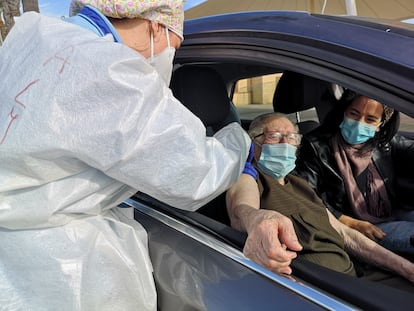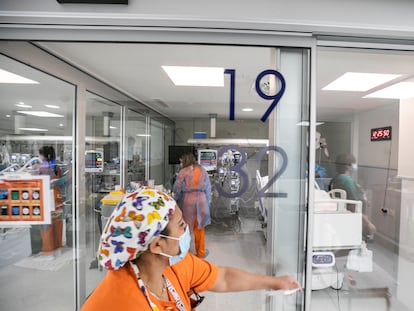The next pandemic: How Covid-19 has accelerated the emergence of super-bacteria
Health authorities warn that antibiotics are losing their effectiveness against disease and that humanity faces a future in which any minor infection could prove lethal
The Madrid studio where Pedro Almódovar’s 1980s comedy Women on the Verge of a Nervous Breakdown was filmed is just a few meters away from Cristina Muñoz’s office, but she does not appear to be nervous, even if her work is not a comedy but something more like the script of a horror movie.
Muñoz is co-director of the National Plan against Resistance to Antibiotics (PRAN), a Spanish initiative to try and stop one of the greatest threats to humankind. Treatments to counter bacteria are ceasing to work, now at an even greater speed due to excessive and incorrect consumption of antibiotics during the coronavirus pandemic. Muñoz paints a dystopian image of a world without antibiotics, where any minor infection could prove lethal: no Caesarian sections, no organ transplants, no meniscus operations, no hip replacements.
“It would be taking a backward step equivalent to 100 years of medical advances,” says Muñoz. “Things that we don’t’ even think about would happen, like if a child fell over and cut open their knee, you would take them to the hospital and the doctors would say there’s nothing to be done, that they are very sorry.” Effective treatment for some bacterial diseases – pneumonia, tuberculosis, gonorrhea, salmonella – is already running dry. Chemotherapy, which favors microbial infections in cancer patients by lowering their defenses, would also be a risky practice in the absence of antibiotics. “We would no longer be able to cure humans or animals. We would be unable to produce healthy foodstuffs,” adds Muñoz. In addition to the resurgence of diseases from the 19th century, famine would be rife.

On occasion of the annual World Antimicrobial Awareness Week, which began on November 18 and runs until November 24, the relevant authorities have sounded the trumpets of the Apocalypse. A report carried out by the UK government in 2016 warned that pharmaceutical-resistant microbes – above all bacteria – are now responsible for 700,000 deaths a year worldwide and that the number could rise to 10 million per year by 2050, which is more fatalities than are caused by cancer. Microbiologist Bruno González Zorn warns that Covid-19 has served to exacerbate the silent pandemic of super-bacteria. “It could be that we reach 10 million deaths a year in 2040 or 2030, not in 2050.”
Bacteria multiply every 20 minutes and sometimes undergo mutations that are, by coincidence, a shield against one kind of antibiotic. And what is most worrying is that they can transmit these new genes to other bacteria in the vicinity, even those of other families. “It’s like if I learn German and I pass that ability on to you,” says González Zorn, a professor at the School of Veterinary Medicine at Madrid’s Complutense University. The more antibiotics are used, the more bacteria will evolve to resist them.
González Zorn states that “a perfect storm” is brewing and provides data from Spanish hospitals during the first coronavirus wave. From February to March 2020 there was a 400% increase in the administration of azithromycin, an antibiotic deployed in desperation to see if it worked against the SARS-CoV-2 virus. Doxycycline consumption rose by 517%. In Spain, these levels swiftly returned to normality but they remain off the charts in some areas of the world, including Latin America. “During the pandemic so many carbapenems [a type of antibiotic] have been used that in some countries, like Chile, we have resistance levels we were expecting to see in 2030. We have accelerated by 10 years. It is very alarming,” says González Zorn.
González Zorn is one of the 15 members of an international group of scientists recently set up by the World Health Organization (WHO) to identify which antibiotics are essential for human health, with the goal of safeguarding their use so that they will continue to be effective. These antibiotics are like an elite military unit in an emergency situation. If you turn to them and don’t get the desired result, there is nothing else in reserve. They are the last resort. And carbapenems are precisely one of these last rolls of the dice.

The WHO’s European office issued a warning in February: “We cannot allow the coronavirus crisis to become a catastrophe of resistance to antimicrobials.” In some countries, the panorama is terrifying. Doctors at Lima’s Almenara Hospital have already noted an “irrational and indiscriminate” use of antimicrobials in Peru during the pandemic. Experts in the USA, India, Mexico and other countries have also sounded the alarm.
The Dutch-Spanish microbiologist Ana Maria de Roda Husman says that resistance mechanisms, in principle, need only to appear once. “At that point Pandora’s box is already open.” Her team at the National Public Health Institute in the Netherlands has detected bacteria that are resistant to carbapenems everywhere in the country’s waste water. Water pipes in hospitals and plumbing in people’s homes contribute to the spread of super-bacteria in nature. The threat of unimaginable combinations is already on the table.
De Roda Husman warns that “the companies that manufacture antibiotics could also be a problem, especially in regions where there are no laws governing waste.” The researcher cites the contamination produced by an azithromycin factory some 25 kilometers outside Zagreb, Croatia, where the Sava River has already been colonized by a rich community of antibiotic-resistant bacteria. In other countries, like India, the situation is critical. In 2007, a study uncovered unprecedented levels of antibiotics in water discharged in the Isakavagu River by a treatment plant serving 90 pharmaceutical manufacturers in Patancheru, an industrial area in the north of Hyderabad. The concentration of ciprofloxacin in the water was nearly 31 milligrams per liter, a thousand times higher than the toxic threshold for some bacteria.
The head of microbiology at Madrid’s Ramón y Cajal Hospital, Rafael Cantón, recalls when he started running lab tests in 1988 to determine the susceptibility of a bacteria to different antibiotics. “Back then it was normal to see almost nothing but S, which signifies sensitive. Now the majority of the values are R: resistant. We study about 20 antibiotics [for each infection] and around 15 times a year we encounter a serious situation: all R. We do not have therapeutic options in those cases.”

European Union authorities estimate that super-bacteria cause 33,000 deaths a year on the continent. In Spain, the number is estimated at 4,000 people, three times the number caused by road traffic accidents. Despite warnings, the last European survey on the subject found that 42% of Spaniards had taken antibiotics in 2018 – compared to 32% EU-wide – with one in three respondents saying they thought it was a cure for the common cold.
Cantón is concerned that, despite these figures, the super-bacteria pandemic will be practically invisible. “There are no patient pressure groups complaining about resistance to antibiotics,” he points out. This silence is surprising, because 6% of patients in hospitals pick up an infection in the facility, after things like having a urinary catheter fitted or intubation for artificial respiration, according to a study by the Spanish Society of Preventive Medicine, Public Health and Hygiene.
“There are fewer infections acquired while in hospital, half of the number in 1990, but those that are acquired now are more problematic,” says Cantón. “We call it genetic capitalism. A bacterium that is resistant tends to hang around and has more likelihood of acquiring even more mechanisms of resistance. It is the same as someone who already has money; they can earn more with greater ease.”
Cantón acknowledges a “huge spike” in the use of antibiotics in hospitals during the pandemic. “This has exacerbated problems that already existed and led to new ones,” he says, in reference to the proliferation of carbapenem-resistant bacteria. “There has been an increase in all hospitals due to the selective effect of antibiotic use.”
The outlook within the pharmaceutical industry is bleak. There are currently just 43 experimental antibiotics in clinical trials according to the WHO, compared to 5,700 possible new treatments for cancer. In the view of microbiologist Marc Lemonnier, it is nothing short of a scandal. “For every antibacterial product in development there are over 100 in oncology. This is unacceptable. We are talking about a comparable medical necessity. From now until 2050, these infections will kill a similar number of people or more than cancer.”
Lemonnier, a 54-year-old with dual French-Spanish citizenship who was born in Tangier, worked as a scientist until 2009 when he founded his own pharmaceutical company, Antabio. The name is a reference to Antaeus, the North African giant who according to Greek mythology won all of his fights because whenever he was knocked to the floor he gathered more strength from his mother, Gaia, the Earth goddess and mother of all life. “Hercules came up with an innovative way to get the better of Antaeus: by lifting him off the floor so that he wasn’t in contact with his mother. And this is precisely the strategy of my company: to find an innovative way to kill bacteria that can’t be killed,” says Lemonnier. There is an oil painting at the Prado Museum in Madrid depicting this battle between Antaeus and Hercules.

“The number of antibiotics in development is extremely poor because nobody wants to invest in this area,” he adds. Pharmaceutical companies earned over €7 billion (nearly $8 billion) from products to tackle cancer between 2014 and 2016, at the same time losing around €89 million ($100 million) through antibiotics, according to the Pew Research Center. Oncology has become big pharma’s golden goose. In 2019, private investment in potential cancer treatments stood at around €8.6 billion ($9.7 billion), compared to around €120 million ($135 million) in antibiotics. “The paradox is that this is a priority area for the WHO, but absolutely non-priority for private investors,” says Lemonnier.
Antabio has garnered €44 million ( nearly $50 million) in financing since 2009 for the development of three promising antibiotics. Half of that amount has come from not-for-profit organizations, including the UK’s Wellcome Trust and the US non-governmental group CARB-X. “It’s getting harder and harder to finance my company,” says Lemonnier. “For my human clinical studies I need to raise tens of millions, but private investment is becoming scarce because investors do not see any outlets, they don’t see any commercial success and they take their business elsewhere.”
Pharmaceutical giants like Novartis, AstraZeneca and Sanofi have in recent years abandoned research into new antibiotics. “If the dynamic doesn’t change, we will have a huge problem. We are at a crossroads that could give way to a second, devastating global pandemic,” warns Lemonnier, a member of the board at BEAM, an alliance of 70 European biotechnology SMEs dedicated to finding treatments against bacteria.
Since 2013, the Spanish economist Laura Marín has headed the largest global initiative for research in the field, the Stockholm-based Joint Programming Initiative on Antimicrobial Resistance (JPIAMR), which has some 30 countries including Germany, Spain, India and Argentina on board. “It is not a favorable business model,” she says. “Creating new antibiotics is scientifically complicated and everyone has stopped doing it. The antibiotic ends up being sold for one euro, so there is no profit. And if we manage to create a new antibiotic, we aren’t going to want to give it to practically anybody so that it can be held in reserve for the most serious cases, so not many will be sold anyway.” What is needed, she says, are economic incentives for the pharmaceutical companies and a lot more public money.
The JPIAMR program is attempting to convince countries to invest more as soon as possible, not only for the development of new antibiotics, but also to look into how to maintain the effectiveness of those that work now. “If we develop a new antibiotic, which is something that might happen within the next 20 years, we can’t risk there being resistance to it from day one,” says Marín, who underlines two key measures to ensure this: banning the sale of antibiotics without a medical prescription and ending their systematic use to stimulate the growth of healthy animals. These policies are currently enforced in the EU but are unimaginable in poorer countries, where access to medication is scarce and the need to increase meat production is greater.
Cristina Muñoz believes Spain offers an example to the rest of the world. In 2014, when the National Plan against Resistance to Antibiotics was launched, the country was the largest consumer of antibiotics in the EU. Since then, according to figures from her organization, sales have dropped by 33% in human medicines and 59% in those for veterinary use, often courtesy of voluntary agreements on the part of meat-producing companies. The biggest success story has been a reduction of practically 100% in the use of colistin – an antibiotic discovered in 1947 but discarded for human use due to its renal toxicity – in pig farming.
Fifteen years ago, in the absence of alternative options, doctors were forced to fall back on colistin for use in patients with multi-resistant infections, González Zorn explains. “This gives an idea of the situation we are in now. We are revisiting toxic antibiotics from the 1950s to save lives in hospitals around the world. It’s unheard-of.”
In November 2015, in China, a gene capable of converting bacteria into super-bacteria resistant to colistin was detected for the first time. Pandora’s box had been opened.
Tu suscripción se está usando en otro dispositivo
¿Quieres añadir otro usuario a tu suscripción?
Si continúas leyendo en este dispositivo, no se podrá leer en el otro.
FlechaTu suscripción se está usando en otro dispositivo y solo puedes acceder a EL PAÍS desde un dispositivo a la vez.
Si quieres compartir tu cuenta, cambia tu suscripción a la modalidad Premium, así podrás añadir otro usuario. Cada uno accederá con su propia cuenta de email, lo que os permitirá personalizar vuestra experiencia en EL PAÍS.
¿Tienes una suscripción de empresa? Accede aquí para contratar más cuentas.
En el caso de no saber quién está usando tu cuenta, te recomendamos cambiar tu contraseña aquí.
Si decides continuar compartiendo tu cuenta, este mensaje se mostrará en tu dispositivo y en el de la otra persona que está usando tu cuenta de forma indefinida, afectando a tu experiencia de lectura. Puedes consultar aquí los términos y condiciones de la suscripción digital.
More information
Archived In
Últimas noticias
David Bowie, the galactic thinker who encouraged us to break new ground
John Berger and the loss of rural culture
From police officer to bloodthirsty kidnapper: Terror in Mexico during the years of ‘The Ear Chopper’
Alain Aspect, Nobel laureate in physics: ‘Einstein was so smart that he would have had to recognize quantum entanglement’
Most viewed
- David King, chemist: ‘There are scientists studying how to cool the planet; nobody should stop these experiments from happening’
- Reinhard Genzel, Nobel laureate in physics: ‘One-minute videos will never give you the truth’
- Oona Chaplin: ‘I told James Cameron that I was living in a treehouse and starting a permaculture project with a friend’
- Mexico completes its trade shift with the entry into force of tariffs on China and countries without trade agreements
- Sinaloa Cartel war is taking its toll on Los Chapitos











































